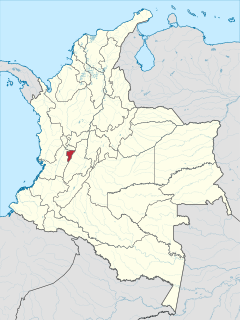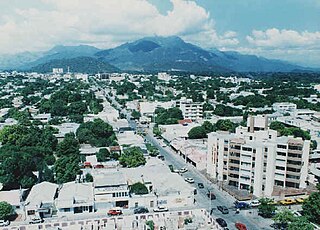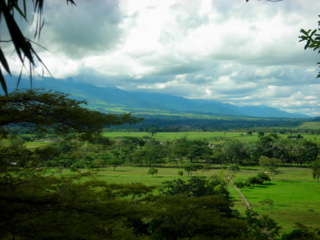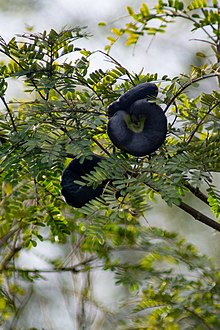
Colombia, officially the Republic of Colombia, is a country largely in the north of South America, with territories in North America. Colombia is bounded on the north by the Caribbean Sea, the northwest by Panama, the south by Ecuador and Peru, the east by Venezuela, the southeast by Brazil, and the west by the Pacific Ocean. It comprises 32 departments and the Capital District of Bogotá, the country's largest city. With an area of 1,141,748 square kilometers, Colombia is the fourth-largest country in South America, after Brazil, Argentina and Peru. It is also the 25th-largest country in the world, the fifth-largest country in Latin America, and the fourth-largest Spanish-speaking country.

Santiago de Cali, or Cali, is the capital of the Valle del Cauca department, and the most populous city in southwest Colombia, with an 2,227,642 residents according to the 2018 census. The city spans 560.3 km2 (216.3 sq mi) with 120.9 km2 (46.7 sq mi) of urban area, making Cali the second-largest city in the country by area and the third most populous. As the only major Colombian city with access to the Pacific Coast, Cali is the main urban and economic center in the south of the country, and has one of Colombia's fastest-growing economies. The city was founded on 25 July 1536 by the Spanish explorer Sebastián de Belalcázar.

Barranquilla is the capital district of Atlántico Department in Colombia. It is located near the Caribbean Sea and is the largest city and second port in the northern Caribbean Coast region; as of 2018 it had a population of 1,206,319 making it Colombia's fourth-most populous city after Bogotá, Medellín and Cali.

Cumbia[ˈkumbja] is a folkloric genre and dance from Colombia and Panama.

Quindío is a department of Colombia. It is in the western central region of the country, crossed by the Andes mountains. Its capital is Armenia. It is famous for the quality of the coffee plantations, colorful architecture, benign weather, variety of hotel accommodations and tourist landmarks. This department is located in a strategic area, in the center of the triangle formed by the three main cities of the country: Bogotá, Medellín and Cali. Quindío is the second-smallest Colombian department with 12 municipalities. Ethnographically and culturally it belongs to the Paisa region.

Cúcuta, officially San José de Cúcuta, is a Colombian city, capital of Norte de Santander department. It is located in the northeast of the country, in the eastern branch of the Colombian Andes, on the border with Venezuela. Cúcuta has a population of 711,715 people according to the 2018 census, making it the 6th largest city in the country. Due to its proximity with Venezuela, Cúcuta is an important commercial center, hosting many billion dollar companies. The international border in Cúcuta is said to be the most dynamic of South America. The city has a length of 12 kilometres from north to south and 11 kilometres from east to west. It is divided into 10 communes and it is the political, economic, administrative, industrial, cultural and tourism hub of the Norte de Santander department.

Valledupar is a city and municipality in northeastern Colombia. It is the capital of Cesar Department. Its name, Valle de Upar, was established in honor of the Amerindian cacique who ruled the valley; Cacique Upar. The city lies between the mountains of Sierra Nevada de Santa Marta and the Serranía del Perijá to the borders of the Guatapurí and Cesar rivers.

Los Llanos is a vast tropical grassland plain situated to the east of the Andes in Colombia and Venezuela, in northwestern South America. It is an ecoregion of the flooded grasslands and savannas biome.

Guaduas is a town in Colombia, in the Lower Magdalena Province department of Cundinamarca, about 117 km from Bogotá. It is an agricultural and tourist center of some importance with a population of about 41,000. Its name refers to a type of bamboo cane. It is one of the cities on the Bogotá-Medellín highway. Its main plaza is featured on the Colombian ten-thousand pesos bill, and is one of the seats of the Roman Catholic Diocese of La Dorada–Guaduas

Villa de Leyva, also called Villa de Leiva, is a touristic colonial town and municipality, in the Ricaurte Province, part of the Boyacá Department of Colombia. The town is located 37 kilometres (23 mi) west of the departmental capital Tunja. It is about two and a half hours by car or bus from Bogotá.

Envigado is a town southeast of Medellin, Colombia which belongs to the department of Antioquia.

Yukpa is an Amerindian ethnic group that inhabits the northeastern part of the Cesar Department in northern Colombia by the Serranía del Perijá bordering Venezuela. Their territory covers the eastern areas of the municipalities of Robles La Paz, Codazzi and Becerril in Resguardos named Socorpa, Menkue, El Cozo Iroka and some other small areas in Venezuela. According to an Inter Press Service story, the majority of the Yukpa, who number nearly 10,000, live in Venezuela although some communities are still located in the mountains across the border in Colombia. The Yukpa people have been known to consume certain nest-inhabiting wasp species, such as Polistes pacificus, which make paper nests that can be quickly knocked from its hanging place on a tree directly into a fire, where the larvae are then toasted.

San Juan de Rioseco is a municipality and town of Colombia in the department of Cundinamarca with a population of about 10,000 people. It lies in mountainous terrain in the coffee land at an altitude of about 4,000 feet, high above the Magdalena River, on the western slope of Colombia's eastern cordillera about 60 miles from Bogotá by car. On a clear day the snow-capped peaks of four volcanos in the central cordillera can be seen in the distance to the west.

Gran Colombia is the name historians use to refer to the state, then known simply as Colombia, that encompassed much of northern South America and part of southern Central America from 1819 to 1831. The state included the territories of present-day Colombia, Ecuador, Panama and Venezuela, and parts of northern Peru, western Guyana and northwestern Brazil. The term Gran Colombia is used historiographically to distinguish it from the current Republic of Colombia, which is also the official name of the former state.

Agriculture in Colombia refers to all agricultural activities, essential to food, feed, and fiber production, including all techniques for raising and processing livestock within the Republic of Colombia. Plant cultivation and livestock production have continuously abandoned subsistence agricultural practices in favour of technological farming resulting in cash crops which contribute to the economy of Colombia. The Colombian agricultural production has significant gaps in domestic and/or international human and animal sustenance needs.

Serranía de Macuira is a mountain range in northern Colombia located in the municipality of Uribia, La Guajira. The Serrania de Macuira stands in the middle of the La Guajira Desert at 864 m (2,835 ft) isolated from the Sierra Nevada de Santa Marta and the Eastern Ranges of the Colombian Andes. The range is a protected area; National Natural Park Macuira.

San Andrés is a coral island in the Caribbean Sea. Politically part of Colombia, and historically tied to the United Kingdom, San Andrés and the nearby islands of Providencia and Santa Catalina form the department of San Andrés, Providencia and Santa Catalina. San Andrés, in the southern group of islands, is the largest of the department. The official languages of the department are Spanish, English, and San Andrés–Providencia Creole.

The Witoto people are an indigenous people in southeastern Colombia and northern Peru.

Colombia is the country with the second-highest biodiversity in the world, behind Brazil. As of 2016, 56,343 species are registered in Colombia, of which 9,153 are endemic. The country occupies the first position worldwide in number of orchids and birds, second position in plants, amphibians, butterflies and fresh water fish, third place in species of palm trees and reptiles and globally holds the fourth position in biodiversity of mammals.

Caryodendron orinocense, commonly known as cacay, inchi or orinoconut, is an evergreen tree belonging to the family Euphorbiaceae.




















